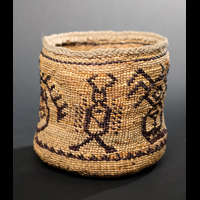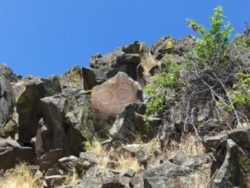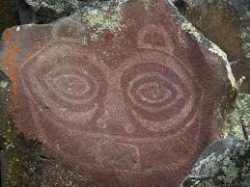The gallery is proud to host an exhibition of collaborative glass work by artists Lillian Pitt (Warm Springs/Wasco/Yakama) and Dan Friday (Lummi) this May. The works are currently undergoing coldworking, and then will be photographed and transported for their debut on May 5th. The vessels were made collaboratively at a multi-day glass blow earlier in 2018; Dan brought over twenty years of glassblowing experience, and Lillian brought the vision of the works along with stencils based on the designs of her ancestors from the Columbia River and Plateau. By the end of the process the two had fused their concepts and vision into a series of rich, vibrantly-colored vessel that reflect time-honored images from the artists’ ancestors.
The imagery on this new series of blown and fused glass baskets was directly inspired from two sources: twined imagery on traditional Wasco Sally bags, and the ancient pictographs and petroglyphs carved on rock walls in the Columbia River Gorge.
 Wasco-style Sally bags are cylindrical, flexible bags made of grasses and fibers such as jute or hemp, and have been woven by the indigenous peoples of the Columbia Plateau in Oregon for tens of thousands of years. Over time, traditional fibers like dogbane and grasses have been augmented with new materials, including cornhusks, yarn, and even beads. Rims are often finished with leather, with loops to attach the basket to a belt. Sally bags could thus be used to carry and store roots and other foods, as well as medicines and personal items. Figures on the baskets could range from human to animal to spirits. Shown at left is a Wasco Sally Bag by contemporary artist Pat Courtney Gold.
Wasco-style Sally bags are cylindrical, flexible bags made of grasses and fibers such as jute or hemp, and have been woven by the indigenous peoples of the Columbia Plateau in Oregon for tens of thousands of years. Over time, traditional fibers like dogbane and grasses have been augmented with new materials, including cornhusks, yarn, and even beads. Rims are often finished with leather, with loops to attach the basket to a belt. Sally bags could thus be used to carry and store roots and other foods, as well as medicines and personal items. Figures on the baskets could range from human to animal to spirits. Shown at left is a Wasco Sally Bag by contemporary artist Pat Courtney Gold.
 Petroglyphs (rock engravings) and pictographs (rock paintings) are an important part of the rich cultural heritage of the the Columbia River people. Archaeologists estimate that the oldest of them could be between 6,000-7,000 years old. At one time there were roughly 90 sites along the Columbia River, in the stretch of land between Pasco, Washington to the east, and The Dalles, Oregon, to the west. Many of these sites were either inundated or destroyed when The Dalles and the John Day dams were put into service, and are now lost to the world forever. At right is pictograph/petroglyph Tsagalal (She Who Watches),which features prominently in much of Lillian’s bronze, ceramic and glass work. Tsagalal sits high up on a bluff, overlooking the village of Wishxam, the village where Lillian’s great grandmother used to live.
Petroglyphs (rock engravings) and pictographs (rock paintings) are an important part of the rich cultural heritage of the the Columbia River people. Archaeologists estimate that the oldest of them could be between 6,000-7,000 years old. At one time there were roughly 90 sites along the Columbia River, in the stretch of land between Pasco, Washington to the east, and The Dalles, Oregon, to the west. Many of these sites were either inundated or destroyed when The Dalles and the John Day dams were put into service, and are now lost to the world forever. At right is pictograph/petroglyph Tsagalal (She Who Watches),which features prominently in much of Lillian’s bronze, ceramic and glass work. Tsagalal sits high up on a bluff, overlooking the village of Wishxam, the village where Lillian’s great grandmother used to live.
The Story of Tsagalal:
 “There was this village on the Washington side of the Columbia Gorge. And this was long ago when people were not yet real people, and that is when we could talk to the animals.
“There was this village on the Washington side of the Columbia Gorge. And this was long ago when people were not yet real people, and that is when we could talk to the animals.
And so Coyote — the Trickster — came down the river to the village and asked the people if they were living well. And they said “Yes, we are, but you need to talk to our chief, Tsagaglal. She lives up in the hill.” So, Coyote pranced up the hill and asked Tsagaglal if she was a good chief or one of those evildoers. She said, “No, my people live well. We have lots of salmon, venison, berries, roots, good houses. Why do you ask?” And Coyote said, “Changes are going to happen. How will you watch over your people?” And so she didn’t know. And it was at that time that Coyote changed her into a rock to watch her people forever.” – From Lillian Pitt
Please join the artists and gallery staff at the opening reception–May 5th, 6-8pm–to celebrate the debut of these new works that bring together two Northwest talents!
